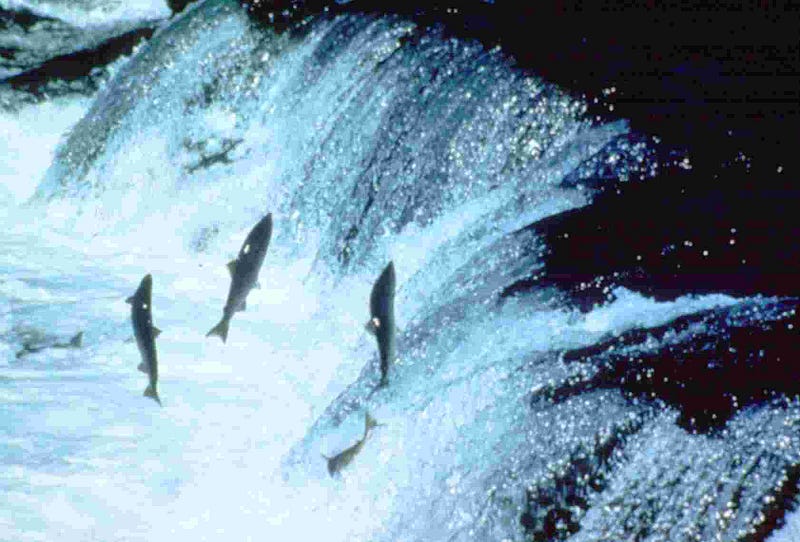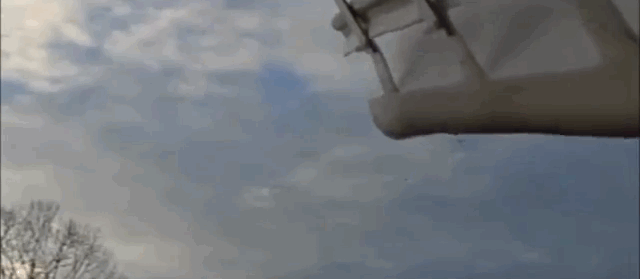Weekend Diversion: Saving Salmon… with a Cannon!
How can salmon get upstream when their waters are blocked by dams? You’ve got to see this new innovation!
Image credit: William Bain / flickr.
“You ain’t supposed to get salmon when they’re swimming upstream to spawn. But if you’re hungry, you do.” –Loretta Lynn
One of the greatest innovations we’ve made in all of human history is the ability to gather and use energy from the natural forces of the world itself. Yet perhaps the oldest source of innovation on this front — using the flow of water to power devices — also contains one of the most daunting environmental challenges: ensuring that the ecosystem isn’t disrupted by your activity. Have a listen to Leftover Salmon’s relevant song, It’s Your World,
while you consider the following problem.

The way to extract the most power from a source of flowing water, like a river or a waterfall, is to dam the flow completely, using the force of the water that you allow through the dam to turn a turbine. Depending on scale, that turbine can then be used either as an engine directly at the source, or — for larger-scale applications — as a source of electricity that’s then transmitted out, powering a potentially large area and serving a tremendous population.
Many countries around the world, including the United States, have used this as a successful method of power generation for a long time now.

But these dams, even though the energy they generate is as green as it comes, have their own environmental challenges that they bring. For one, they disrupt the natural flow of the river, reducing its speed and potentially altering the ecosystem of everything downstream from it. Perhaps most famously, China’s Three Gorges Dam has further threatened more than 3,000 already endangered species, resulted in severe water pollution and waste management problems, and created devastating landslide problems.
Even smaller dams, like those in the Pacific Northwest (where I happen to live), have to contend with a very region-specific problem.

You see, every year, salmon migrate up the rivers of the pacific northwest to their spawning grounds, each one finding its way back to the streams, tributaries and rivers where they themselves were spawned. But while a small salmon might be able to make its way either around or through a dam, swimming upstream through a dam is another story.

Because salmon fishing is such an important part of the economy, food supply and lifestyle of this region of the world, the installation of dams was never an unmitigated disaster. Instead they came accompanied with a fish ladder (or salmon ladder, which gives the Ninja Warrior obstacle its name), a series of “steps” that water flows down, with the intent that the fish will be drawn to it, be able to swim or leap up each step, and then continue their journey upstream.

There are a number of different designs of fish ladder available, including those with switchbacks, resting pools, as well as alternatives such as vertical slot fishways (that they can simply swim through rather than up) and fish elevators.
But there’s a limiting factor to all of these: the fish need to be strong enough or lucky enough to be one of the ones that can get through. Many fish die as a consequence of the added difficulty of traversing through these dam areas, greatly reducing their population from what it would have been without the dam. If you’re a salmon and you travel upstream along Washington’s (and Oregon’s, for those of you who still fondly remember the Oregon Trail) Columbia River, you’ll be able to make your way up a number of fish ladders, but then you’ll run into the 236-foot-tall Chief Joseph dam, with the towering Grand Coulee at 550 feet behind it, for which no salmon ladder exists.
If only there were a way to get more of these salmon over these dams — particularly these gargantuan ones — with less energy expenditure and more quickly.
If only.

Enter Whooshh Innovations and their great invention: the Salmon Cannon. Originally used for transporting fruit gently (and accurately) over large distances, these pneumatic tubes were recently applied to fish, with astoundingly successful results. As the Vice President of Whooshh Innovations, Todd Deligan, said,
“At a talk at the National Hydropower Association, I hit play on the video and the first fish goes flying out, and the audience is dying. I had to say, ‘It’s okay to laugh, this is utterly ridiculous.’ Then people start talking and they say, ‘Holy cow, why hadn’t we thought of something like this before?’”
That was five years ago. Now in September, the first Salmon Cannons (yes, they are actually called Salmon Cannons) were successfully tested this past June at Washington’s Roza Dam, and are poised to rocket salmon onto trucks where they will be taken farther upstream than they’ve naturally been in a long time. If this, too, proves to be successful, the Salmon Cannon could be exactly what’s needed to restore the fish of the Columbia River to their natural, original runs!
And that’s just one amazing way technology — and a little bit of physics — is working to reap the benefits of using what the natural world has to offer while simultaneously minimizing any negative impacts on the environment, and all the people and animals that rely on the salmon’s presence.
Thanks to The Verge and RealClearScience for bringing this story to light, and I hope this gives you an enlightening and amusing diversion for today, no matter where you are!
Leave your comments at the Starts With A Bang forum on Scienceblogs. And if you haven’t been checking our our Comments of the Week, don’t miss them!





